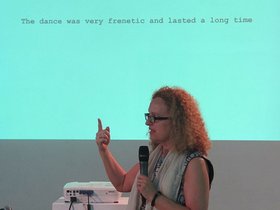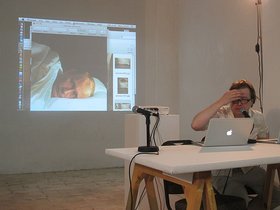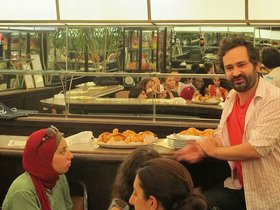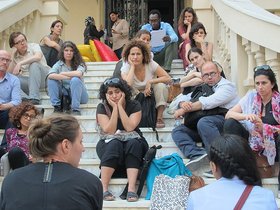News
On the Stage of the Event
The Cairo Seminar in Alexandria, dOCUMENTA (13)
Apart from its traditional location in Kassel, dOCUMENTA (13) occupies three more 'platforms' – in Kabul, Banff (Canada) and Alexandria respectively. Conceptually it is unclear why exactly these locations were chosen to hold dOCUMENTA's seminars, other than geopolitical determinants or the desire to extend geographically. During 'The Cairo Seminar: The Seminar' from the 1st till the 8th of July in Alexandria, the Artistic Director of dOCUMENTA (13) Carolyn Christov-Bakargiev unequivocally declared: 'Without Alexandria, Kassel is obscene. Without Kabul, Kassel is obscene. Kabul and Alexandria are what make Kassel bearable'. These words, pronounced with great conviction and certainty, nevertheless revealed a certain dynamic between the centre in which the mega art event with its mechanisms of value construction unfolded, and the cultural post-peripheries upon which it still relied as 'raw' resources. Within the larger political and cultural climate of threatened multiculturalism, the event hailing from western Europe required relations with what could be termed as geographical and philosophical post-peripheries. Post peripheries are what I would define as a geo-political but also a cultural condition in which the hegemonic power of the Cold War paradigm no longer prevails, and so is the opposition between the centre (the imperialist west or the Soviet Union) and periphery (formerly colonised fringes). Instead, power is dispersed through immaterial modes of cultural, economic and political relations. These relations between Kassel and its 'platforms' completed two operations at once: while legitimising Kassel's central position in the production of the event and making the latter 'bearable' for the organising team, they also supported the illusion of a democratic engagement with other localities outside of western European centres.
Perhaps 'The Cairo Seminar: The Seminar' in Alexandria made Kassel 'bearable' for the dOCUMENTA (13) team, but it signified a rupture between the intensely and somewhat dramatically evolving political events in Egypt, the local cultural politics and the seminar in Alexandria. The event coincided with the Muslim Brotherhood's preferred candidate Mohamed Morsi taking the presidential oath both in front of the Tahrir demonstrators and at the constitutional court. The original concept of the seminars, conceived by Cairo-based curator Sarah Rifky and Christov-Bakargiev in 2011 in the aftermath of the Egyptian uprising, were to occupy the domain of 'being in the state of hope'. This notion falls amongst Christov-Bakargiev's four propositions (the other three were 'under siege', 'on stage ', and 'on retreat'). In 2012, symptomatically, it shifted its focus to 'sleep' as a political and theoretical starting point. Although both Rifky and dOCUMENTA (13)'s Head of Department, Chus Martínez, who drafted the framework of the event, proposed to 'sleep politically', the revision of the original conception from 'hope' to 'sleep' could not but imply a diplomatic move. In the face of the intensity of evolving political events devoid of the initial euphoria of the earlier post-Mubarak period of 2011, the proposition felt like a suggestion of resignation and retreat. This transition was not simply conceptual, but was equally marked in semiotic and topographical domains: the often political and urban dystopia of Cairo was replaced by the Mediterranean city of Alexandria, where the north-westerly wind would inevitably disperse any political current that would dwell in the same place long enough to threaten to overtake the reality of the art event.
Structurally, the seminars borrowed the formal language of music organisation. The participants were categorised as 'key notes', 'instruments' and 'accompaniments', whereas the carefully cast and 'auditioned' audience was replaced by a 'chorus'. The seminars were closed and all the actors had their strictly assigned roles: the 'key notes' delivered one hour-long lectures, the 'instruments' presented half-hour long interventions, whereas the 'accompaniments' – students from MASS Alexandria (an artist-run independent educational programme established by Wael Shawky in 2010), who had earlier travelled to Kassel, were here put in charge of introducing the speakers and accompanying the guests to various venues in which the seminars unfolded. These included Café Delice, Alexandria Contemporary Art Forum, MASS Alexandria, Greek writer Constantine Cavafy's house, Mahmoud Said Museum, the Goethe Institute in Alexandria, and subsequently Cairo. Each day boasted a poetic title that when combined constituted a sestet written by artist Shahira Issa: 'On the first or the second night … some 20 bodies returned … they appeared in a dream … as characters, in an undefined site: a set, in a story … they appeared trapped in an image, or history … nocturne: the only way to escape, was to remain awake'.
The first note was hit by Alexei Penzin from Russia's Chto Delat? collective of artists and philosophers. His keynote speech, entitled 'Sleeping Politically', while being a rich historical survey of the productive potentialities of sleep, nevertheless failed to present a theoretically and politically convincing argument of the benefits of sleeping. Since two out of the five morning preludes planned by Rifky and dOCUMENTA (13)'s Agent for Public Programmes, Adam Kleinman, did not take place due to the chorus' strongly pronounced preference to literally sleep, the working day would have to start on a high note. The second day, the dominant tune was psychoanalytic and replete with affects borrowed from Deleuze and Guattari's philosophical frameworks. Psychoanalyst and curator Suely Rolnik proposed to reoccupy the domain of affects and to return knowledge to the dreaming body in the face of the Euro-centric Cartesian paradigm of disembodied knowledge. Taking up the Brazilian conceptual artist Lygia Clark's Moebius Strip as an allegory of non-linear relations, Rolnik's proposition was taken at a face value and universally applied to all case studies and anecdotal incidents in the next few days. Functioning as a generalised litmus test and all-encompassing prescription, it left the discontented to hope that the owl of Minerva would spread its wings not only after dusk. Rolnik's convincing, if slightly romantic and esoteric propositions in front of the largely fascinated 'choir', were temporarily interrupted by Hassan Khan's musical intervention. Khan presented an Egyptian period piece from the 1950s that had been haunting him for some time, entitled 'Sa'alny El Leil'(in English, 'the night asked me'). The piece, presented in three seven-to-11-minute fragments, was based on structural repetitions that illustrated nuanced differences in their interstices. While the recording of the piece was accompanied by English subtitles projected against the wall, the impatient segment of the 'choir', in search of direct links and connections between certain kinds of politics and aesthetics, started yawning and showing signs of impatience at having to dwell upon Khan's careful structural analysis of the music piece. The London-based Otolith Group's Anjalika Sagar exclaimed that (to paraphrase) the Egyptian genre music was overly sentimental, oppressive, patriarchal and offended her feminist sensibilities. In reality, Khan's performative intervention aimed at proposing a music theory that would provide a non-reductive formula to interpret social structures. However, the impatience and non-generosity of some of the members of the 'chorus' forced him to reveal his playing cards and claim that Rolnik's theories did not apply to the understanding of the local situation in Egypt. The specificity of the place defied interpretations through the supposedly universally-applied framework of repression that provided easy-to-sell explanations for oppression. Rather, violence was key if one was to develop any understanding of social structures in Egyptian society. It was suggested that violence was that which structures social relations. Similarly, according to Khan, Rolnik's proposition of 'sublime action' as a prescription for emancipating the 'knowing body' from its Cartesian prison through affect had been and was effectively used by the military dictatorship to produce social desires.
Bassam El Baroni's contribution was more than convincing in terms of offering a new way of understanding the underlying structural problems in contemporary society and culture. His was a proposal to develop mechanisms of interpretation that go beyond the tired ideological explanations. The notion of edification as developed by Kant, Herder and Schiller in the age of the eighteenth-century European Enlightenment was revisited by the speaker as that which formed the structural core of ideology and was more basic than the latter. Edification ('Bildung' in German) is a structural support that holds the human being in an upright position and lies at the foundation of the birth of morality. But El Baroni was also attempting to offer a way of thinking beyond the pillars of edification as those support structures upon which contemporary art and politics alike operate today. His contribution, in terms of its form as a composition based on various sequences, echoed my own key note intervention performed earlier in Cavafy's house. It constituted an exegetical journey through three image-sequences: a juxtaposition of Kars and Giumry – two towns in Turkey and Armenia separated by a gorge, a river and now a sealed border – and presented as ghostly apparitions of the image through which the imperial power rendered itself visible; the Westin Bonaventure hotel in Los Angeles as an epitome of a postmodern maze in which the body loses its Cartesian coordinates, and artist Kasper Kovitz's works, where the landscape functioned as a 'technical support' in Rosalind Krauss' understanding of medium specificity. I argued that in Kovitz's works, the landscape foregrounded a relationship between elements, forms and narratives that was one of trust. The landscape supported not only the artist's body but also the various narratives that unfolded through the indexical use of his materials (fox urine, bear scat, pine sap, coffee and so on).
'Instrumental' interventions by artists Shahira Issa and Malak Helmy, though varied in content, were similar in their poetics. Both constituted attempts to suggest empowering modes of subjectivisation in the face of the oppressive reality of the unfolding Egyptian political events. Issa's was a search for 'figures of accidental loves', while Helmy offered a theory of apathy as a productive refusal of engagement that was generationally specific and linguistically revealed. Art Historian Clare Davies' presentation of the debates on degenerate art in the Egyptian Al-Risala newspaper in 1930s between Egyptian surrealists and the art establishment was the only one that directly involved the students of MASS Alexandria, in whose names the seminars were justified in that specific location. They had earlier travelled to Kassel and assisted towards arranging the exposition at dOCUMENTA (13), and the Seminar was part of their year-long educational programme at MASS Alexandria. Emblematically carried out in the now closed Mahmoud Said Museum, the debate, as read in Arabic by the students, brought about questions of cultural politics and the inadequacy of formal art education. The discussion began by searching for alternative modes of art education in collaboration with the students – many of whom were students or graduates of the Faculty of Fine Arts at Alexandria University. In the end however, this session turned into some kind of pedagogy for the oppressed, where various 'experts' were seen giving informed advice to the youth on where and how and for what to gain knowledge.
In the closed-door seminars, where there was a tendency to circulate and reproduce a certain vocabulary as a pedagogical tool, refreshing were those interventions that diverted from the grammar and syntax of the event and offered alternative means of interpreting images, social structures and that questioned one's position within these structures. Especially effective was a spontaneous intervention by one of the MASS Alexandria participants during a discussion that resembled a therapy session. This was initially intended to reconnect thoughts and to consider what had gone awry in the first three days of the seminar. During these moments, there were requests for the young women in the group to speak about their roles in post-revolutionary Egypt, which were met with some resistance. A female student asked to have the cameras and microphones switched off before she would utter a word. For her, it was not the content of speech, the linguistic barrier or the elitist jargon that created a wall between the various segments of the 'choir', 'keynotes' or the students. Rather, it was the means through which the event was staged, including the technical devices that produce the event as a convention. By asking for the technical apparatus to be shut off, she seemed to demand to change the very conditions upon which speech was produced and the manner in which the event was staged.
Concluding with a reception in 'Beirut' in Cairo, an art space soon to be opened by Sarah Rifky and curator Jens Maier-Rothe, 'The Cairo Seminar' constituted a clash between various subjects and temporalities, places and people. Those dimensions did not intersect and produce frictions. Indeed, the poetics of the seminars failed to translate into an ethics of relating to one other. The dOCUMENTA (13) team members, who were supposed to act as co-organisers, sat back and observed how the event slowly but surely foreclosed any possibility for collaborative thinking. 'Good intentions' became frozen in gestures, and the stage (as a pure convention) appeared as the main hero of the event. Perhaps 'The Cairo Seminar: The Seminar' needed to occupy the conceptual platform of 'being on stage', in Christov-Bakargiev's proposition. The event itself had the density of a dreamwork, or as curator Mia Jankowicz stated in the only opportunity to communicate the experience of the seminars to a larger public in the Goethe Institute in Cairo, it felt like living in Rifky's dream. Every aspect of the event was meticulously directed through an overly-stylised performance whose pitch remained high throughout the entire event. But dreams are always tricky: they could be oppressive and unwanted, and one person's dream could well become another's nightmare.




